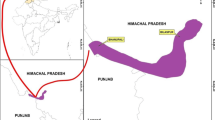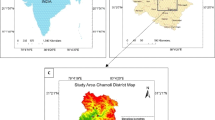Abstract
The state of Sikkim in India has many steep slopes and has been susceptible to landslides. Since 1968 there have been innumerable losses of lives and properties due to landslides. There is an urgent need for advance assessment of degrees of vulnerability and delineation of the most vulnerable zone for shifting of the population and infrastructure to a safer zone. The identification and formulation of most suitable and acceptable method for such assessment is still nascent and research based. In this study, an attempt has been made to integrate the concept of Shannon’s entropy with the information value-based statistical model to evaluate the landslide susceptibility in the study area and assess the improvement made through the integration of Shannon’s entropy by comparing the results with the landslide susceptibility determined from the information value-based statistical model alone. Initially, the thematic layers pertaining to all the causative parameters were overlaid with the help of geographical information system that resulted in the formation of 78,256 numbers of polygons for each one of which landslide susceptibility was determined. For each polygon, the total landslide information value (TLIV) was computed as the summation of the landslide information values determined for the individual sub-categories present within the respective polygons. Again for each polygon, the Shannon’s entropy value of the individual parameters was multiplied with the summation of the landslide information values of all the sub-categories present within the respective parameters. The product values computed for the different causative parameters were summed up to determine the total landslide information value with entropy (TLIV_e). Finally, the entire study area was categorized into five zones of landslides susceptibility based on the TLIV and TLIV_e, respectively. The prediction accuracy of the landslides determined based on the landslide susceptibility derived from TLIV_e was found to be significantly high (91 %) as compared to that derived from TLIV (85 %) indicating the potential contribution of Shannon’s entropy in the improved delineation of the landslide susceptibility zones.
















Similar content being viewed by others
References
Atkinson PM, Massari R (1998) Generalized linear modeling of susceptibility to land sliding in the central Apennines. Italy Comput Geo-Sci 24:373–385
Avinash KG, Ashamanjari KG (2010) A GIS and frequency ratio based landslide susceptibility mapping: Aghnashini river catchment, Uttarkhand, India. Int J Geomat Geosci 1(3):343–354
Carro M, Amicis MD, Luzi L, Marzorati S (2003) The application of predictive modeling techniques to landslides induced by earthquakes: the case study of the 26 September 1997 Umbria–Marche earthquake (Italy). Eng Geol 69(1–2):139–159
Dhakal AS, Sidle RC (2002) Physically based landslide hazard model ‘U’ method and issues. EGS XXVII General Assembly, Nice, pp 21–26
Ercanoglu M, Gokceoglu C (2004) Use of fuzzy relations to produce landslide susceptibility slope failure risk maps of the Altindag (settlement) region in Turkey. Eng Geol 55:277–296
George YL, Long SC, David WW (2007) Vulnerability assessment of rainfall-induced debris flows in Department of Earth Systems and GeoInformation Sciences, College of Science, George Mason University, Fairfax, VA 22030,ETATS-UNIS. http://www.springerlink.com/content/uj26871v2831nx44. Accessed 10 Jan 2011
Gupta M, Ghose MK, Sharma LP (2009) Application of remote sensing and GIS for landslides hazard and assessment of their probabilistic occurrence-A case study of NH31A between Rangpo and Singtam. J Geomat 3(1):13–17
Jadda M, Shafri Helmi ZM, Manssor Shattri B, Mohammad S, Saeid P (2009) Landslide susceptibility evaluation and factor effect analysis using probabilistic- frequency ratio model. Eur J Sci Res 33(4):654–668
Lee S (2004) Application of likelihood ratio and logistic regression models to landslide susceptibility mapping using GIS. Environ Manage 34(2):223–232
Lee S (2005) Application of logistic regression model and its validation for landslide susceptibility mapping using GIS and remote sensing data. Int J Remote Sensing 26:1477–1491
Lee S (2007) Application and verification of fuzzy algebraic operators to landslide susceptibility mapping. Environ Geol 52:615–623
Lee S, Pradhan Biswajeet (2006) Landslide hazard mapping at Selangor, Malaysia using frequency ratio and logistic regression models. Landslides 4(1):33–41
Lee S, Sambath T (2006) Landslide susceptibility mapping in the Damrei Romel area, Cambodia using frequency ratio and logistic regression. Environ Geol 50:847–855
Lee S, Ryu J-H, Min K, Won J-S (2003a) Landslide susceptibility analysis using GIS and artificial neural network. Earth Surf Process Landforms 28:361–1376
Lee S, Ryu JH, Lee MJ, Won JS (2003b) Landslide susceptibility analysis using artificial neural network at Bonn, Korea. Environ Geol 44:820–833
Lee S, Ryu JH, Won JS, Park HJ (2004) Determination and application of the weights for landslide susceptibility mapping using an artificial neural network. Eng Geol 71:289–302
Pachauri AK, Pant M (1992) Landslide hazard mapping based on geological attributes. Eng Geol 32:81–100
Pachauri AK, Gupta PV, Chander R (1998) Landslide zoning in a part of the Garhwal Himalayas. Environ Geol 36(3–4):325–334
Patanakanog B (2001) Landslide hazard potential area in 3 dimension by remote sensing and gis technique. Land Development Department, Thailand. www.ecy.wa.gov/programs/sea/landslides/help/drainage.html. Accessed 13 Jan 2010
Pistocchi A, Luzi L, Napolitano P (2002) The use of predictive modeling techniques for optimal exploitation of spatial databases: a case study in landslide hazard mapping with expert system-like methods. Environ Geol 58:251–270
Pradhan B, Ahmed MY (2010) Manifestation of remote sensing data and GIS on landslide hazard analysis using spatial-based statistical models. Arab J Geosci 3:319–326
Pradhan B, Lee S (2010) Delineation of landslide hazard areas on Penang Island, Malaysia, by using frequency ratio, logistic regression, and artificial neural network models. Environ Earth Sci 60(5):1037–1054
Ramakrishna D, Ghose MK, Vinu Chandra R, Jeyaram A (2005) Probabilistic techniques, GIS and remote sensing in landslide hazard mitigation: a case study from Sikkim Himalayas, India. Geocarto Int 20(4):53–58
Sakellariou MG, Ferentinou MD (2001) GIS-based estimation of slope stability. Nat Hazards Rev 2(1):12–21
Sarkar S, Kanungo DP, Patra AK, Kumar Pushpendra (2008) GIS based spatial data analysis for landslide susceptibility mapping. J Mt Sci 5:52–62
Sharma LP, Patel N, Ghose MK, Debnath P (2009a) Geographical information system based landslide probabilistic model with tri-variate approach—a case study in Sikkim Himalayas. In: 18th United Nation’s regional cartographic conference-Asia and the Pacific, Bangkok 26–29 October 2009
Sharma LP, Patel N, Ghose MK, Debnath P (2009b) Landslide susceptibility. Coordinates V(11):31–34
Sharma LP, Patel N, Ghose MK, Debnath P (2011) Landslide vulnerability assessment and zonation through ranking of causative parameters based on landslide density-derived statistical indicators. Geocarto Int 26(6):491–504
Sharma LP, Patel N, Ghose MK, Debnath P (2012a) Influence of Shannon’s entropy on landslide-causing parameters for vulnerability study and zonation—a case study in Sikkim, India. Arab J Geosci 5(3):421–431
Sharma LP, Patel N, Ghose MK, Debnath P (2012b) Assessing landslide vulnerability from soil characteristics—a GIS based analysis. Arab J Geosci 5(4):789–796
Sharma LP, Patel N, Ghose MK, Debnath P (2012c) Geo-spatial technology based landslide vulnerability assessment and zonation in Sikkim Himalayas in India. J Geomat 6(2):51–57
Sharma LP, Patel N, Ghose MK, Debnath P (2012d) Application of frequency ratio and likelihood ratio model for geo-spatial modeling of landslide hazard vulnerability assessment and zonation: a case study from the Sikkim Himalayas in India. Jeocarto Int 10(1080/10106049):748830
Sharma LP, Patel N, Ghose MK, Debnath P (2013) Synergistic application of fuzzy logic and geo-informatics for landslide vulnerability zonation—a case study in Sikkim Himalayas, India. Appl Geomat 5(4):271–284. doi:10.1007/s12518-013-0115-7
Shu-Quin W, Unwin DJ (1992) Modeling landslide distribution on loess soils in China: an investigation. Int J Geogra Inf syst 6(5):391–405
Sinha BN, Varma RS, Paul DK (1975) Landslides in Darjeeling District (West Bengal) and adjacent areas. Bull Geol Surv India B(36):45
Sivakumar GL, Mukesh MD (2002) Landslide analysis in geographic information systems. Department of Civil Engineering, Indian Institute of science, Bangalore, India. www.gisdevelopment.net/application/natural_hazards/landslides/nhls0011pf.htm. Accessed 26 Feb 2011
Uromeihy A, Mahdavifar MR (2000) Landslide hazard zonation of Khorshrostam area, Iran. Bull Eng Geol Environ 58:207–213
Van Westen CJ, Rengers N, Terlien MTJ, Soeters R (1997) Prediction of the occurrence of slope instability phenomena through GIS-based hazard zonation. Geol Rundsch 86:404–414
Yilmaz I (2009a) Landslide susceptibility mapping using frequency ratio, logistic regression, artificial neural networks and their comparison: a case study from Kat landslides (Tokat-Turkey). Comput Geosci 35(6):1125–1138
Yilmaz I (2009b) A case study from Koyulhisar (Sivas-Turkey) for landslide susceptibility mapping by artificial neural networks. Bull Eng Geol Environ 68(3):297–306
Yin KL, Yan TZ (1988) Statistical prediction models for slope instability of metamorphosed rocks. In: International symposium on landslides, Lausanne, pp 1269–1272
Author information
Authors and Affiliations
Corresponding author
Rights and permissions
About this article
Cite this article
Sharma, L.P., Patel, N., Ghose, M.K. et al. Development and application of Shannon’s entropy integrated information value model for landslide susceptibility assessment and zonation in Sikkim Himalayas in India. Nat Hazards 75, 1555–1576 (2015). https://doi.org/10.1007/s11069-014-1378-y
Received:
Accepted:
Published:
Issue Date:
DOI: https://doi.org/10.1007/s11069-014-1378-y




